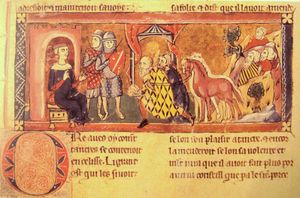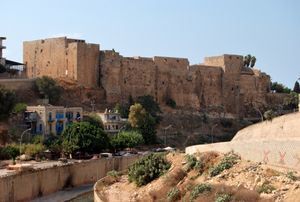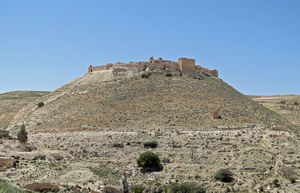بلدوين الأول من بيت المقدس
| بلدوين الأول Baldwin I | |
|---|---|
| ملك بيت المقدس | |
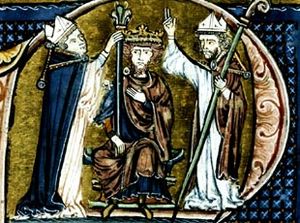 | |
| العهد | 25 ديسمبر 1100 - 2 أبريل 1118 |
| التتويج | 25 ديسمبر 1100 |
| تبعه | بلدوين الثاني |
| وُلِد | 1058? اللورين السفلى |
| توفي | 2 أبريل 1118 (aged 60)? العريش، مصر |
| الدفن | |
| الزوج | گودهيلده ده توني أردا من أرمنيا أديلايده دل ڤاستو |
| الأب | أوستاس الثاني من بولوني (10??–1093) |
| الأم | إيدا من اللورين (ح. 1040–1113) |
بلدوين الأول من بيت المقدس Baldwin I of Jerusalem، سابقاً بلدوين الأول من الرها، وُلد بلديون من بولوني (بالفرنسية: Baudouin de Boulogne)، 1058?[1] – 2 أبريل 1118، هو أحد قادة الحملة الصليبية الأولى، الذي أصبح أول كونتات الرها ولاحقاً ثاني حكام وأول من حمل لقب ملك بيت المقدس. وهو شقيق گدفري من بويون، الذي كان أول أول حاكم لولاية بيت المقدس الصليبية، بالرغم من رفض گدفري من بويون للقب "الملك" الذي قبله بلدوين.
حياته المبكرة
هو ابن أوستاس الثاني، كونت بولوني وإيدا من اللورين (ابنة گدفري الثالث، دوق اللورين السفلي)، والشقيق الأصغر لأوستاس الثالث، كونت بولوني وگدفري من بويون. كشقيق أصغر، كان بلديون ينوي الخدمة في الكنيسة، لكنه عدل عن هذا ح. عام 1080؛ حسب وليام من صور، الذي عاش لاحقاً في القرن 12 ولم يعرف بلدوين شخصياً: "في شبابه، كان بلديون متعلق بشدة بالدراسات المتحررة. أصبح رجل دين، ويقال، وأنه بسبب نسبه النبيل، كان يشغل مناصب تسمى prebends في كنائس ريمس، كمباري، ولياج." بعدها عاش في نورماندي، حيث تزوج گدهيلده (أو گدڤرا) ده توني، ابنة رايول ده كونش من عائلة أنگلو-نورمانية نبيلة (وخطيبة روبير ده بومون سابقاً). عاد إلى اللورين السفلي للاستيلاء على كونتية ڤردون (كانت تحت سيطرة گدفري سابقاً).
الحملة الصليبية الأولى
عام 1096 انضم إلى الحملة الصليبية الأولى مع أشقاؤه گدفري وأوستاس الثالث من بولوني، بعد بيعه معظم ممتلكاته للكنيسة من أجل دفع نفقاته. زوجته گدهيلده (أو گدڤر) كانت برفقته أيضاً. كانت ثاني تحركات الصليبيين؛ الأولى، حملة الشعب، كانت مكونة من الطبقات الدنيا بالإضافة للفرسان، مثل والتر المفلس، ولحق بهم الكثير من الدمار أثاء مسيرتهم، بالرغم من أنه لم تكن هناك الكثير من الجماعات الصليبية، قبل أن يتم تدميرهم في آسيا الصغرى. عندما مر گدفري بكولمان ملك المجر، طلب منه برهينة لضمان حسن سلوكهم، وتحفظ بلدوين على الرهينة حتى غادر رفاقه الأراضي المجرية.
بعد دخول الأراضي البيزنطية، كانت هناك بعض الاشتباكات مع اليونانيين، الذين عانوا أيضاً من حملة الشعب. أمر بلديون مفرزة من القوات بالإستيلاء على جسر في محيط القسطنطينية. بعد وصول المدينة، لم يتمكن حشد من القوات من منع أنفسهم من نهب الأراضي المجاورة، وأُجبر الامبراطور البيزنطي ألكسيوس الأول كومننوس على إحضار رهينة لاستعادة السلام. كانت الرهينة، ابنه الامبراطور المستقبلي جون الثاني كومننوس، وتم إيداعه تحت رعاية بلديون. حسب آنا كومننا، فقد وبخ بلدوين أحد جنوده الذي تجرأ بالجلوس على عرش ألكسيوس في القسطنطينية.
رافق بلدوين شقيقه حتى هراقلية، في آسيا الصغرى، حيث انفصل عن الجيش الصليبي الرئيسي برفقة تانكرد للتوجه نحو قلقيلية. سعى تانكرد بإصرار للإستيلاء على بعض الأراضي وتنصيب نفسه كحاكم تافه في الشرق، وربما كان لبلدوين نفس الهدف. أثناء غيابه سقطت زوجته مريضة وتوفت في مرعش، مما يعني أنه لم يعد بوسع بلدوين الاعتماد على أراضي زوجته من أجل الدعم. يقترح بعض المؤرخين أن استراتيجيته الداخلية تغيرت بدءاً من هذه المرحلة، ويعتقد آخرين أن التغير حدث قبلها.
في سبتمبر 1097 إستولى من تانكرد على طرسوس، وأنشأ حاميته في المدينة، بمساعدة أسطول من القراصنة تحت قيادة گينميه من بولوني. بعد فترة وجيزة، اشتبكت جيوش تانكرد وبلدوين عند الماميسترة، لكن لم يدخل الجيشان أبداً في قتال مفتوح وسار تانكرد إلى أنطاكية. بعد الإنضمام مرة أخرى للجيش الرئيسي عند مرعش، حصل بلدوين على دعوة من أرمني يدعى باگرات، وانتقل شرقاً إلى الفرات، حيث احتل تل باشر.
كونت الرها
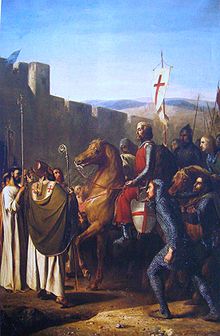
أتت دعوة أخرى من توروس من الرها، حيث كان بلدوين قد تم تبنيه كابناً لتوروس وخليفة له. عندما أُغتيل توروس في مارس 1098، أصبح بلدوين أول كونت للرها، بالرغم من أنه لا يعرف إذا ما كان قد لعب أي دور في الإغتيال. حكم بلديون الكونتية حتى عام 1100، وتزوج من أردا، ابنةة توروس من مرعش، وكان سفيراً بين الصليبيين والأرمن.
خلال هاتين السنتين، استولى على سميساط وسروچ (سارورگيا) من المسلمين، وقضى على مؤامرة حاكها بعض رعاياه الأرمن عام 1098. أثناء حصار أنطاكية أرسل الأموال والطعام لزملائه الصليبيين، بالرغ من أنه لم يكن مشاركاً. كربغا، حاكم الموصل، كان في طريقه لإستعادة أنطاكية لكنه توقف أولاً في الرها، التي حاصرها لثلاثة أسابيع، لكن دون جدوى. فيما بعد هُزم كربغا في أنطاكية وأسس الصليبيون إمارة هناك. لاحقاً في هذه السنة عزز بلدوين سلطته بما يكفي لتمكينه من السير مع شقيقه گدفري وحصار أعزاز حيث هزم قوات رضوان من حلب.
في نهاية 1099 زار بيت المقدس مع بوهمند الأول من أنطاكية، لكنه عاد للرها في يناير، 1100. بعد عودته للرها، ساعد بلدوين في تخفيف حصار ملطين، والتي أُسر فيها بوهمند من قبل الدانشمنديين. حاكم المدينة الأرمني گابريل، اعترف لاحقاً ببلدوين كسيد أعلى للمدينة.
ملك بيت المقدس
بعد وفاة گدفري في يوليو 1100 دُعي إلى بيت المقدس من قبل أنصار الملكية العلمانية، بزعامة نسيبه وارنر من گرز. تنازل عن الرها لابن عمه، بلدوين من بورك، وفي طريقه إلى بيت المقدس تعرض لكمين نصبه دقاق من دمشق بالقرب من بيروت. هُزمت قوات دقاق ولم يكن هناك المزيد من المتاعب في الطريق إلى بيت المقدس، حيث وصل في مطلع نوفمبر.
في بيت المقدس اعترضه عوده القديم تانكرد، وكذلك البطريرك الجديد داگوبرت من پيزا، الذي كان يفضل تأسيس دول دينية وقت ما كان گدفري على قيد الحياة. بمجرد وصول بدلوين قام بإطلاق تجريدة ضد الأراضي المصرية إلى الجنوب ولم يعد حتى نهاية ديسمبر. في 25 ديسمبر 1100 تُوج كأول ملك لبيت المقدس على يد البطريرك نفسه، الذي كان في هذه الأثناء قد تخلى عن معارضته لبلدوين، بالرغم من رفضه تتويج بلدوين في بيت المقدس. عوضاً عن ذلك تم التتويج في بيت لحم.
استمر الصراع بين الكنيسة والدولة حتى ربيع 1101، عندما أوقف بلدوين داگوبرت بواسطة الممثل الپاپوي، بينما في وقت لاحق من ذلك العام اختلفا على مسألة المساهمة التي سيقوم بها البطريرك نحو الدفاع عن الأراضي المقدسة. انتهى الصراع بالإطاحة بداگوبرت عام 1102.
توسع المملكة
The Egyptians did not launch any major military campaigns against the Kingdom of Jerusalem, but their raids across the southern frontiers continued.[3] They massacred hundreds of pilgrims near Jaffa and defeated the governor of the town while Baldwin was fighting against Damascene troops in Galilee in October 1106.[3] In the following year, the Egyptians attacked Hebron, but Baldwin forced them to lift the siege.[4] The Egyptian raids could not prevent Baldwin from pursuing an expansionist policy.[4] He compelled the governor of Sidon to pay a huge tribute for a two-year truce in early 1106.[4] Early next year, he made a raid into Oultrejordain and destroyed a fortress that Damascene troops had recently erected to control the caravan routes.[5] Baldwin laid siege to Sidon with the assistance of a band of Italian adventurers in August 1108, but the arrival of an Egyptian fleet and Turkish horsemen from Damascus forced him to abandon the siege.[4] In late 1108, he concluded a ten-year truce with Toghtekin in exchange for one-third of state revenues in the northern regions of Oultrejordain.[6]
Bertrand, Count of Toulouse came to Syria to claim the lands that his father, Raymond of Saint Gilles, had conquered around Tripoli.[7] Bertrand's cousin, William Jordan, who had ruled the same lands since Raymond's death, refused to cede them to him.[7] Bertrand sought Baldwin's assistance, while William Jordan secured Tancred's support.[7] Tancred had already outraged Baldwin II of Edessa through refusing to abandon Turbessel.[8][9] Baldwin convoked an assembly to put an end to the crusader leaders' conflicts.[10] Since neither Tancred nor William Jordan were his vassals, he summoned them in the name of "the whole church of Jerusalem" to the castle of Mount Pilgrim near Tripoli.[9][11] At the assembly in June 1109, Tancred agreed to abandon Turbessel in return for his restoration to his old domains in the Kingdom of Jerusalem (الجليل وحيفا و Temple of the Lord).[7][12] Tancred did not take possession of his old domain, which remained under Baldwin's control.[13] Raymond's inheritance was distributed between Bertrand and William Jordan, with Bertrand swearing fealty to Baldwin, and William Jordan to Tancred.[10]
The crusader leaders' united their forces to complete the conquest of Tripoli that Raymond had commenced.[7] On 26 June, the Egyptian governor, Sharaf ad-Daulah, offered to surrender the town if a safe passage for those who wanted to leave the town was guaranteed.[11][14] Baldwin accepted the offer, but he could not prevent the Genoese from killing all burghers whom they could capture.[11][15] Two third of the town was granted to Bertrand of Toulouse who again took an oath of fealty to Baldwin.[14] Baldwin captured Beirut with the assistance of Bertrand and a Genoese fleet on 13 May 1110.[16] He was again unable to prevent a general massacre among the townspeople.[17][18]
Mawdud, the atabeg of Mosul, and his allies invaded the County of Edessa during the siege of Beirut.[19] After the fall of Beirut, Baldwin and Bertrand[12] hurried to Edessa to fight against the invaders.[20] Baldwin II of Edessa accused Tancred of having incited the Muslim rulers to take actions against him.[20] Regarding himself the leader of all crusaders, Baldwin soon ordered Tancred to join the campaign and make peace with Baldwin II, otherwise he would declare the disobedient prince the enemy of Christianity.[20] Since most crusaders supported the king, Tancred had no choice, but to obey.[20] The incident strengthened Baldwin's suzerainty in Edessa.[21] After the new reconciliation, the crusaders pursued Mawdud, but rumours about Muslim attacks against Antioch and Jerusalem forced them to stop the campaign.[22] Before leaving the county, Baldwin suggested that the Christian (mainly Armenian) peasants should be transferred to the lands west of the Euphrates, because the Seljuq rulers had frequently raided the eastern regions.[22] While the peasants were gathering at a ferry on the river, Mawdud made a sudden raid against the county and massacred most of them.[22]
Sigurd I of Norway — the first king to visit the Kingdom of Jerusalem — had meanwhile landed at Acre.[17] Baldwin made an alliance with him and they laid siege to Sidon in October 1110.[17] An Egyptian fleet routed the Norwegians, but the Doge of Venice, Ordelafo Faliero, and his fleet soon joined the crusaders and the town capitulated on 5 December.[16][17] Baldwin spared the life of the townspeople, but many of them moved to Tyre and Damascus.[18] The following year Baldwin marched to Ascalon[23] and to prevent a siege, the Egyptian governor of the town, Shams al-Khalīfa, promised to pay 70,000 dinars as a tribute and allowed crusader troops into the citadel.[23][24] However, the townspeople rose up against al-Khalīfa in July[24] and his Berber guards joined the rioters, murdering him and the crusader troops.[23]
Mawdud launched a new expedition against the northern crusader states in August.[25] At Tancred's request, Baldwin mustered his troops and hurried to Shaizar.[25] Bertrand of Tripoli, Baldwin II of Edessa and the Armenian rulers also came to fight against Mawdud, who was compelled to return to Mosul in the autumn.[26] Shortly thereafter, Baldwin attacked the caravan carrying the most precious possessions of the highest-ranking officials of Tyre to Damascus and seized the rich cargo.[27] In late November, he laid siege to Tyre, although he had no fleet.[27] He was still besieging the town when a Byzantine embassy arrived.[28] The Byzantines tried to persuade him to join a coalition against Tancred, while he wanted to secure their assistance against Tyre.[28] They could not reach a compromise, but Izz al-Mulk, the Egyptian governor of Tyre, persuaded Toghtekin to come to the rescue of the besieged town.[29] Toghtekin compelled Baldwin to lift the siege and withdraw to Acre in April 1112.[30]
Baldwin made an incursion against Damascene territory in the summer of 1113.[31] Mawdud and an Artuqid emir, Ayaz, came to assist Toghtekin against the crusaders.[32] They routed Baldwin in the Battle of Al-Sannabra on 13 June, forcing him to seek assistance from the new rulers of Tripoli and Antioch, Pons and Roger.[32] Toghtekin, Mawdud and Ayaz invaded Galilee, but they did not risk attacking Tiberias after the arrival of the troops from Tripoli and Antioch.[33] Toghtekin and Mawdud returned to Damascus where an Assassin murdered Mawdud in late September.[34] The Seljuq sultan, Muhammad I Tapar sent a large army to northern Syria in spring 1115.[35] In an attempt to keep the equilibrium in the region, Toghtekin soon sought reconciliation with the crusaders.[34] He made an alliance with the crusader rulers and their coalition forced the Seljuq troops to withdraw without a fight.[35]
With the pressure on the northern regions diminished, which enabled Baldwin to again deal with the Egyptians.[34] The Egyptians had already approached Jerusalem in 1113, and made a new attempt to capture Jaffa in 1115.[34] Baldwin led an expedition across the Jordan and ordered the construction of the castle of Montreal in the autumn 1115.[36][37] The following year, he returned to the region and marched as far as Akaba on the Red Sea.[37][38] After the local inhabitants fled from the town, Baldwin erected castles in the town and on a nearby island and left a garrison in both fortresses.[37] The three strongholds — Montreal, Eilat and Graye — secured the control of the caravan routes between Syria and Egypt.[37] They also enabled Baldwin to continuously survey the movements of the Egyptian troops.[38] From the Red Sea coast, Baldwin hastened to Tyre and began the construction of a new fortress, known as Scandelion Castle, at the Ladder of Tyre, which completed the blockade of the town from the mainland.[39][40]
وفاته
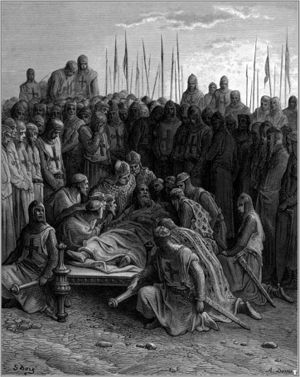
Baldwin fell seriously ill in late 1116.[41] Thinking that he was dying, he ordered that all his debts should be paid off and started to distribute his money and goods, but he recovered at the start of the following year.[41] To strengthen the defence of the southern frontier, he launched an expedition against Egypt in March 1118.[42][43] He seized Farama at the Nile Delta without a fight, because the townspeople had fled in panic before he reached the town.[42][44][45] The late 12th-century Muslim historian Ibn Zafír wrote that Baldwin had destroyed the mosques in the town.[46] Baldwin's retainers urged him to attack Cairo, but the old wound that he had received in 1103 suddenly opened.[42][47]
The dying Baldwin was carried back as far as العريش on the frontier.[47] On his deathbed, he named Eustace III of Boulogne as his successor, but also authorised the barons to offer the throne to Baldwin II of Edessa or "someone else who would rule the Christian people and defend the churches" if his brother did not accept the crown.[48] Baldwin died on 2 April 1118.[47] In accordance with his last wishes, his cook, Addo, removed Baldwin's intestines and his body was preserved in salt, because Baldwin wanted to secure his burial in the Holy Sepulchre.[47][49] He was buried in the Calvary Chapel next to Godfrey of Bouillon five days later, on أحد السعف.[49]
على اسم قائد من قواد الحروب الصليبية اسمه بلدوين تحول الى بردويل بعد ذلك هجم على مدينة الفرامل ب شمال سيناء، وأحرقها على من فيها من المصريين المسلمين. وفي عودته اصيب ب جرح بعد أكله من سمك البحيرة حصل له تسمم و مات على اثرها.
السلف
| سلف بلدوين الأول من بيت المقدس | ||||||||||||||||||||||||||||||||||||||||||||||||||||||||||||||||||||||||||||||||||||||||||||||||||||||||||||||||||||||||||||||||||||||||||||||||||||||||||||||||||||||||||||||||||||||||||||||||||||||||||||||||||||||||||||||||||||||||||||||||||||||||||||||||||||||||||||||||||||||||||||||||||||||||||||||||||||||||||||||||||||||||||||||||||||||||||||||||||||||||||||||||||||||||||||||||||||||||||||||||||||||||||||||||||||||||||||||||||||||||||||||||||||||||||||||||||||||||||||||||||||||||||||||||||||||||||||||||||
|---|---|---|---|---|---|---|---|---|---|---|---|---|---|---|---|---|---|---|---|---|---|---|---|---|---|---|---|---|---|---|---|---|---|---|---|---|---|---|---|---|---|---|---|---|---|---|---|---|---|---|---|---|---|---|---|---|---|---|---|---|---|---|---|---|---|---|---|---|---|---|---|---|---|---|---|---|---|---|---|---|---|---|---|---|---|---|---|---|---|---|---|---|---|---|---|---|---|---|---|---|---|---|---|---|---|---|---|---|---|---|---|---|---|---|---|---|---|---|---|---|---|---|---|---|---|---|---|---|---|---|---|---|---|---|---|---|---|---|---|---|---|---|---|---|---|---|---|---|---|---|---|---|---|---|---|---|---|---|---|---|---|---|---|---|---|---|---|---|---|---|---|---|---|---|---|---|---|---|---|---|---|---|---|---|---|---|---|---|---|---|---|---|---|---|---|---|---|---|---|---|---|---|---|---|---|---|---|---|---|---|---|---|---|---|---|---|---|---|---|---|---|---|---|---|---|---|---|---|---|---|---|---|---|---|---|---|---|---|---|---|---|---|---|---|---|---|---|---|---|---|---|---|---|---|---|---|---|---|---|---|---|---|---|---|---|---|---|---|---|---|---|---|---|---|---|---|---|---|---|---|---|---|---|---|---|---|---|---|---|---|---|---|---|---|---|---|---|---|---|---|---|---|---|---|---|---|---|---|---|---|---|---|---|---|---|---|---|---|---|---|---|---|---|---|---|---|---|---|---|---|---|---|---|---|---|---|---|---|---|---|---|---|---|---|---|---|---|---|---|---|---|---|---|---|---|---|---|---|---|---|---|---|---|---|---|---|---|---|---|---|---|---|---|---|---|---|---|---|---|---|---|---|---|---|---|---|---|---|---|---|---|---|---|---|---|---|---|---|---|---|---|---|---|---|---|---|---|---|---|---|---|---|---|---|---|---|---|---|---|---|---|---|---|---|---|---|---|---|---|---|---|---|---|---|---|---|---|---|---|---|---|---|---|---|---|---|---|---|---|---|---|---|---|---|---|---|---|---|---|---|---|---|---|---|---|---|---|---|---|---|---|---|---|---|---|---|---|---|---|---|---|---|---|---|---|---|---|---|---|---|---|---|---|---|---|---|---|---|---|---|---|---|---|---|---|---|---|---|---|---|---|---|---|---|
| ||||||||||||||||||||||||||||||||||||||||||||||||||||||||||||||||||||||||||||||||||||||||||||||||||||||||||||||||||||||||||||||||||||||||||||||||||||||||||||||||||||||||||||||||||||||||||||||||||||||||||||||||||||||||||||||||||||||||||||||||||||||||||||||||||||||||||||||||||||||||||||||||||||||||||||||||||||||||||||||||||||||||||||||||||||||||||||||||||||||||||||||||||||||||||||||||||||||||||||||||||||||||||||||||||||||||||||||||||||||||||||||||||||||||||||||||||||||||||||||||||||||||||||||||||||||||||||||||||
المصادر
- ^ The Columbia Encyclopedia, Sixth Edition. 2001-05. Baldwin I, Latin king of Jerusalem. http://www.bartleby.com/aol/65/ba/Baldwn1Jer.html
- ^ "Les Croisades, Origines et consequences", Claude Lebedel, p.50
- ^ أ ب Runciman 1989b, p. 90.
- ^ أ ب ت ث Runciman 1989b, p. 91.
- ^ Tibble 1989, p. 29.
- ^ Runciman 1989b, p. 96.
- ^ أ ب ت ث ج Barber 2012, p. 91.
- ^ Barber 2012, p. 84.
- ^ أ ب Lock 2006, p. 30.
- ^ أ ب Barber 2012, pp. 91-92.
- ^ أ ب ت Barber 2012, p. 92.
- ^ أ ب Lock 2006, p. 31.
- ^ Tibble 1989, p. 12.
- ^ أ ب Runciman 1989b, p. 69.
- ^ Maalouf 1984, p. 80.
- ^ أ ب Barber 2012, p. 93.
- ^ أ ب ت ث Runciman 1989b, p. 92.
- ^ أ ب Maalouf 1984, p. 81.
- ^ Runciman 1989b, pp. 115-116.
- ^ أ ب ت ث Runciman 1989b, p. 116.
- ^ Lilie 1993, p. 81.
- ^ أ ب ت Runciman 1989b, p. 117.
- ^ أ ب ت Maalouf 1984, p. 88.
- ^ أ ب Hillenbrand 2000, p. 82.
- ^ أ ب Runciman 1989b, p. 122.
- ^ Runciman 1989b, p. 123.
- ^ أ ب Runciman 1989b, p. 93.
- ^ أ ب Lilie 1993, p. 86.
- ^ Runciman 1989b, pp. 93-94.
- ^ Runciman 1989b, p. 94.
- ^ Runciman 1989b, p. 126.
- ^ أ ب Lock 2006, p. 32.
- ^ Runciman 1989b, pp. 126-127.
- ^ أ ب ت ث Tyerman 2006, p. 203.
- ^ أ ب Maalouf 1984, p. 87.
- ^ Lock 2006, p. 33.
- ^ أ ب ت ث Runciman 1989b, p. 98.
- ^ أ ب Barber 2012, p. 105.
- ^ Runciman 1989b, pp. 98-99.
- ^ Tibble 1989, p. 52.
- ^ أ ب Barber 2012, p. 115.
- ^ أ ب ت Barber 2012, p. 116.
- ^ Maalouf 1984, p. 94.
- ^ Murray 2000, p. 117.
- ^ Hillenbrand 2000, p. 52.
- ^ Hillenbrand 2000, pp. 45, 77.
- ^ أ ب ت ث Murray 2000, p. 118.
- ^ Murray 2000, pp. 118-119.
- ^ أ ب Barber 2012, p. 117.
- Fulcher of Chartres, A History of the Expedition to Jerusalem, 1095-1127, trans. Frances Rita Ryan. University of Tennessee Press, 1969.
- Anna Comnena, The Alexiad, trans. E.R.A. Sewter. Penguin Books, 1969.
- William of Tyre, A History of Deeds Done Beyond the Sea, trans. E.A. Babcock and A.C. Krey. Columbia University Press, 1943.
- Steven Runciman, A History of the Crusades, vols. I-II. Cambridge University Press, 1951-1952.
| ألقاب ملكية | ||
|---|---|---|
| منصب مستحدث | كونت الرها 1098–1100 |
تبعه بلدوين الثاني |
| سبقه گدفري من بويون |
ملك بيت المقدس 1100–1118 | |
